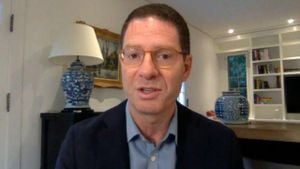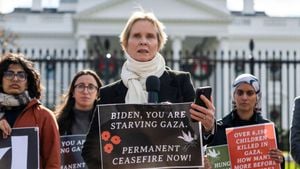Donald Trump is making waves again as he sets the stage for what some are calling "Trump 2.0." This new chapter is closely tied to Project 2025, the expansive agenda laid out by the Heritage Foundation, which outlines plans for his administration should he reclaim the presidency. Despite Trump's previous disavowal of the initiative during the campaign, evidence suggests he is now embracing key figures and ideas from the project, thereby reigniting debates about executive power and governmental overhaul.
During his 2024 presidential campaign, Trump and his team distanced themselves from Project 2025, often labeling it as extreme and even ridiculous. "I have no idea who is behind it," Trump stated, raising eyebrows and skepticism about his connections to the initiative. But as Trump approaches the beginning of his second term, he's reverting to familiar faces linked to Project 2025 for various cabinet positions, indicating his earlier statements may not reflect his current intentions.
Project 2025 aims to reshape federal policy across multiple fronts, including immigration, education, and civil rights. Critics of the project highlight its intention to replace career civil servants with individuals loyal to Trump, effectively politicizing federal positions. These proposed policies include eliminating the Department of Education and reallocATING its responsibilities to states—decisions which raise alarms among educators and civil rights advocates.
For example, Carol Gray, a professor at the University of Alaska Fairbanks, expressed concern over Project 2025's potential impact on federal education policy. She pointed out the dangers posed by removing oversight and civil rights protections for education. "If you give block grants to the states without strings attached, there’s a loss of oversight and rights," she remarked, explaining the significant ramifications if the Department of Education is dismantled, particularly for its roughly 4,400 employees.
While some of the more contentious aspects of Project 2025 have been downplayed during the campaign, Trump's latest appointments to his administration spotlight the project's architects. Notably, Russell Vought returns as the director of the Office of Management and Budget, where he has the power to reimagine federal budgeting and organizational structures. His previous work focused on consolidations and reductions of federal agencies, themes echoed throughout Project 2025.
Trump's cabinet selections also include Brendan Carr, the new chair of the Federal Communications Commission (FCC), and Tom Homan, appointed as his 'border czar.' These roles align closely with the Project 2025 agenda, which seeks aggressive reforms surrounding tech regulation and immigration enforcement. For example, Carr's chapter on the FCC calls for curbing "Big Tech" powers, which includes limiting protections for social media companies. On the immigration front, Homan is tasked with implementing stringent border security measures, echoing Trump’s earlier policies focused on mass deportations and family separations.
Meanwhile, Trump continues to face criticism from political opponents who are mobilizing to combat Project 2025's sweeping proposals. Washington governor-elect Bob Ferguson recently announced the creation of a subcommittee intended to counter the influence of Project 2025 within his state. Ferguson, co-chaired by key leaders like Planned Parenthood Alliance Advocates’ CEO Jennifer Allen, has expressed concern about potential threats to civil liberties and core freedoms posed by Trump's plans.
The committee is strategically positioning itself to prepare for what it fears could be assaults on rights such as reproductive health access, education, and immigration protections. Allen emphasized the overwhelming need to safeguard the rights of Washington residents, particularly those from marginalized communities. "We are preparing for any challenges to fundamental freedoms under the incoming Trump administration," she stated firmly.
While Trump pursues this expansive and control-oriented agenda, public perception remains at the forefront. During the campaign, surveys indicated strong voter skepticism about Project 2025, which led Trump to distance himself from its more controversial aspects. Yet, with multiple appointments tied directly to the project now underway, Trump is embracing the initiative as he shapes his strategy moving forward.
Critics argue the apparent contradiction between Trump's campaign rhetoric and current strategy reveals his prioritization of loyalty over public sentiment. Tony Carrk, the executive director of Accountable.US, commented, "President-elect Trump has dropped all pretense and is charging ahead hand in hand with the right-wing industry players shaping an agenda he denied for the whole campaign." With each new appointment, the goals of Project 2025 seem to inch closer to realization, raising alarms for opponents and supporters alike.
Trump is not just building his administration but also assembling his manifesto for governance—a vision constructed with the support of figures from Project 2025. John Ratcliffe is poised to return as the director of the CIA, with his contributions to the project highlighting extensive ambitions for the intelligence community. With various chapters of Project 2025 outlining plans to streamline executive authority and recalibrate traditional Republican values, the power dynamics within the federal system could drastically shift should Trump's vision come to fruition.
With the dawn of another Trump presidency approaching, many are asking what this means for the everyday American. Will existing social safety nets remain intact? How will education, civil rights, and health care be affected? The signs suggest we may witness significant upheaval as Trump’s cabinet goes to work, entrenching the principles laid down by Project 2025 firmly within U.S. policy.
Political experts continue to monitor how Trump’s second term may materialize, especially considering the potential for legislative restrictions via Congress. While Democratic leaders are already attempting to preemptively address the anticipated onslaught of conservative policy, the Republican Party is also preparing to marshal support behind these right-leaning initiatives.
The narrative surrounding Project 2025 is far from finished; as implementation approaches, America waits with bated breath to see the next chapter of the Trump legacy—one written by the architects of the controversial plan.



